day13--JDK8~17新特性(上):
第18章_JDK8-17新特性(上)
讲师:尚硅谷-宋红康(江湖人称:康师傅)
本章专题与脉络
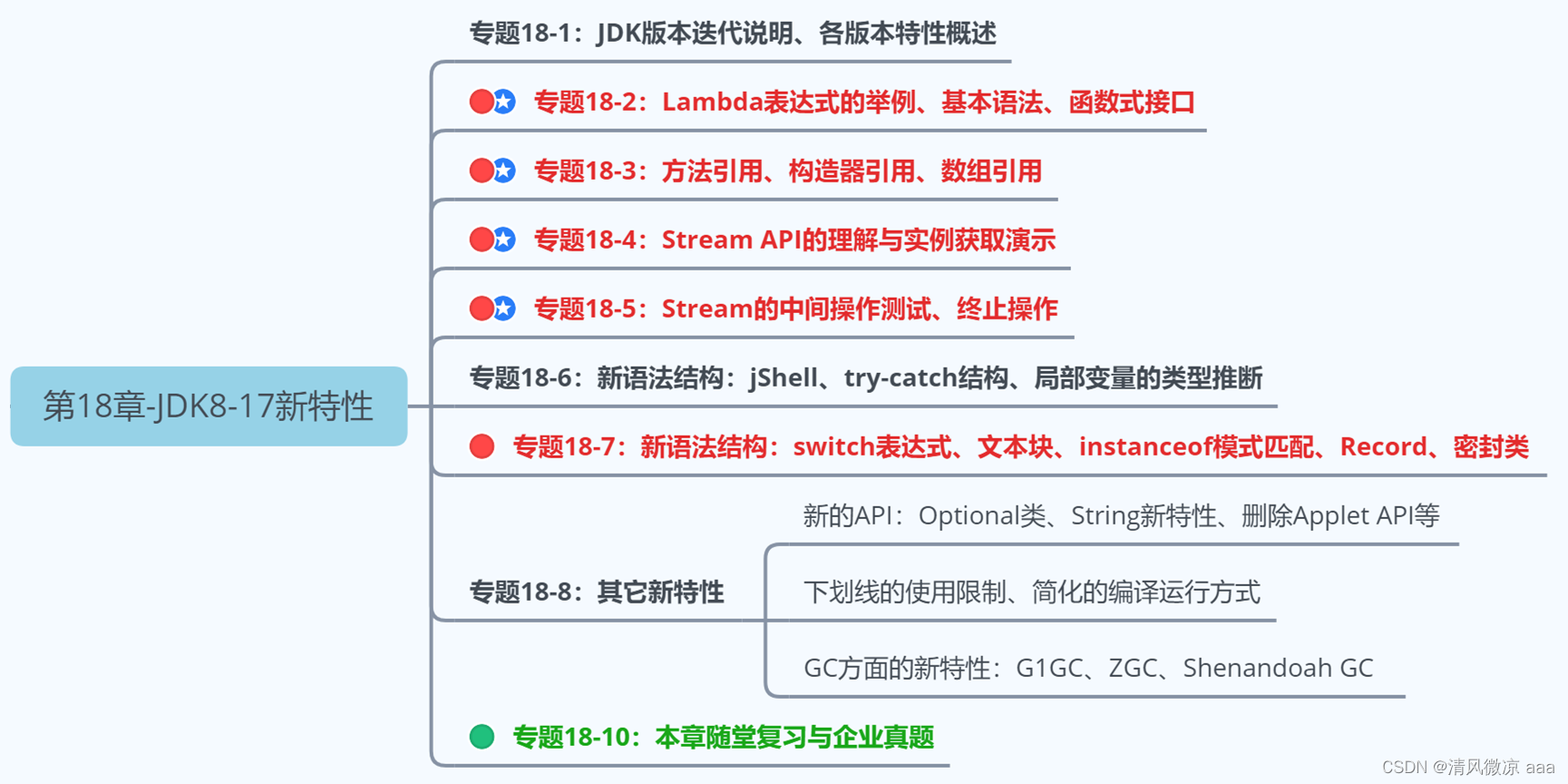
1. Java版本迭代概述
1.1 发布特点(小步快跑,快速迭代)
| 发行版本 | 发行时间 | 备注 |
|---|---|---|
| Java 1.0 | 1996.01.23 | Sun公司发布了Java的第一个开发工具包 |
| Java 5.0 | 2004.09.30 | ①版本号从1.4直接更新至5.0;②平台更名为JavaSE、JavaEE、JavaME |
| Java 8.0 | 2014.03.18 | 此版本是继Java 5.0以来变化最大的版本。是长期支持版本(LTS) |
| Java 9.0 | 2017.09.22 | 此版本开始,每半年更新一次 |
| Java 10.0 | 2018.03.21 | |
| Java 11.0 | 2018.09.25 | JDK安装包取消独立JRE安装包,是长期支持版本(LTS) |
| Java 12.0 | 2019.03.19 | |
| … | … | |
| Java17.0 | 2021.09 | 发布Java 17.0,版本号也称为21.9,是长期支持版本(LTS) |
| … | … | |
| Java19.0 | 2022.09 | 发布Java19.0,版本号也称为22.9。 |
从Java 9 这个版本开始,Java 的计划发布周期是 6个月。
这意味着Java的更新从传统的以特性驱动的发布周期,转变为以时间驱动的发布模式,并且承诺不会跳票。通过这样的方式,开发团队可以把一些关键特性尽早合并到 JDK 之中,以快速得到开发者反馈,在一定程度上避免出现像 Java 9 两次被迫延迟发布的窘况。
针对企业客户的需求,Oracle 将以三年为周期发布长期支持版本(long term support)。
Oracle 的官方观点认为:与 Java 7->8->9 相比,Java 9->10->11的升级和 8->8u20->8u40 更相似。
新模式下的 Java 版本发布都会包含许多变更,包括语言变更和 JVM 变更,这两者都会对 IDE、字节码库和框架产生重大影响。此外,不仅会新增其他 API,还会有 API被删除(这在 Java 8 之前没有发生过)。
目前看这种发布策略是非常成功的,**解开了 Java/JVM 演进的许多枷锁,至关重要的是,OpenJDK 的权力中心,正在转移到开发社区和开发者手中。**在新的模式中,既可以利用 LTS 满足企业长期可靠支持的需求,也可以满足各种开发者对于新特性迭代的诉求。因为用 2-3 年的最小间隔粒度来试验一个特性,基本是不现实的。
1.2 名词解释
名词解释:Oracle JDK和Open JDK
这两个JDK最大不同就是许可证不一样。但是对于个人用户来讲,没区别。
| Oracle JDK | Open JDK | |
|---|---|---|
| 来源 | Oracle团队维护 | Oracle和Open Java社区 |
| 授权协议 | Java 17及更高版本 Oracle Java SE 许可证 Java16及更低版本甲骨文免费条款和条件 (NFTC) 许可协议 | GPL v2许可证 |
| 关系 | 由Open JDK构建,增加了少许内容 | |
| 是否收费 | 2021年9月起Java17及更高版本所有用户免费。 16及更低版本,个人用户、开发用户免费。 | 2017年9月起,所有版本免费 |
| 对语法的支持 | 一致 | 一致 |
名词解释:JEP
JEP(JDK Enhancement Proposals):jdk 改进提案,每当需要有新的设想时候,JEP可以提出非正式的规范(specification),被正式认可的JEP正式写进JDK的发展路线图并分配版本号。
名词解释:LTS
LTS(Long-term Support)即长期支持。Oracle官网提供了对Oracle JDK个别版本的长期支持,即使发发行了新版本,比如目前最新的JDK19,在结束日期前,LTS版本都会被长期支持。(出了bug,会被修复,非LTS则不会再有补丁发布)所以,一定要选一个LTS版本,不然出了漏洞没人修复了。
| 版本 | 开始日期 | 结束日期 | 延期结束日期 |
|---|---|---|---|
| 7(LTS) | 2011年7月 | 2019年7月 | 2022年7月 |
| 8(LTS) | 2014年3月 | 2022年3月 | 2030年12月 |
| 11(LTS) | 2018年9月 | 2023年9月 | 2026年9月 |
| 17(LTS) | 2021年9月 | 2026年9月 | 2029年9月 |
| 21(LTS) | 2023年9月 | 2028年9月 | 2031年9月 |
如果要选择Oracle JDK,目前可选的LTS版本为8、11、17三个。
1.3 各版本支持时间路线图
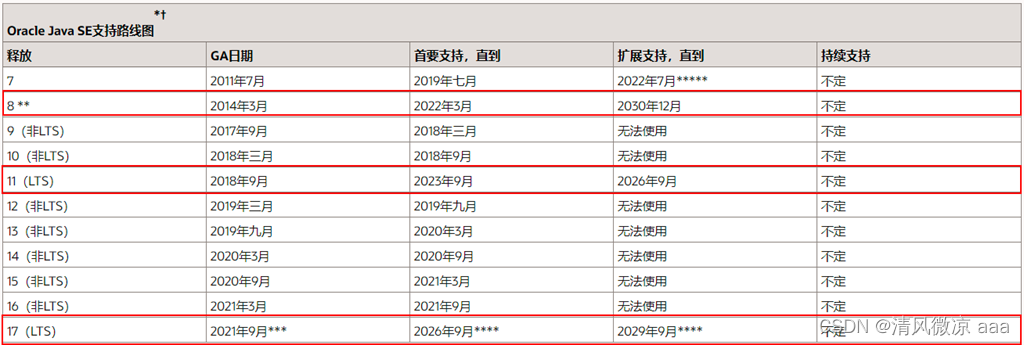
1.4 各版本介绍
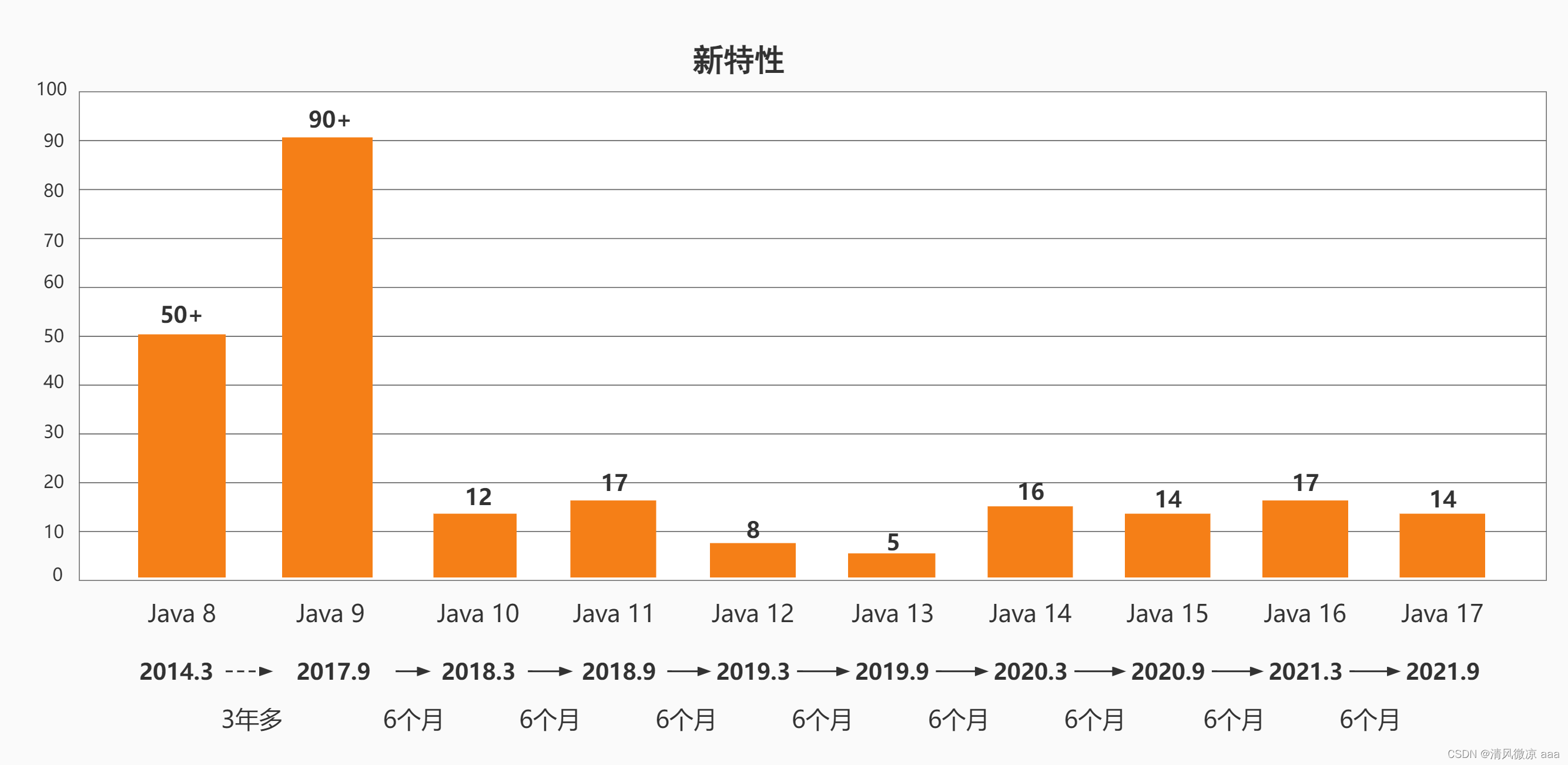
jdk 9
Java 9 提供了超过150项新功能特性,包括备受期待的模块化系统、可交互的 REPL 工具:jshell,JDK 编译工具,Java 公共 API 和私有代码,以及安全增强、扩展提升、性能管理改善等。
特性太多,查看链接:
https://openjdk.java.net/projects/jdk9/
jdk 10
https://openjdk.java.net/projects/jdk/10/
286: Local-Variable Type Inference 局部变量类型推断
296: Consolidate the JDK Forest into a Single Repository JDK库的合并
304: Garbage-Collector Interface 统一的垃圾回收接口
307: Parallel Full GC for G1 为G1提供并行的Full GC
310: Application Class-Data Sharing 应用程序类数据(AppCDS)共享
312: Thread-Local Handshakes ThreadLocal握手交互
313: Remove the Native-Header Generation Tool (javah) 移除JDK中附带的javah工具
314: Additional Unicode Language-Tag Extensions 使用附加的Unicode语言标记扩展
316: Heap Allocation on Alternative Memory Devices 能将堆内存占用分配给用户指定的备用内存设备
317: Experimental Java-Based JIT Compiler 使用Graal基于Java的编译器319: Root Certificates 根证书
322: Time-Based Release Versioning 基于时间定于的发布版本
jdk 11
https://openjdk.java.net/projects/jdk/11/
181: Nest-Based Access Control 基于嵌套的访问控制
309: Dynamic Class-File Constants 动态类文件常量
315: Improve Aarch64 Intrinsics 改进 Aarch64 Intrinsics
318: Epsilon: A No-Op Garbage Collector Epsilon — 一个No-Op(无操作)的垃圾收集器
320: Remove the Java EE and CORBA Modules 删除 Java EE 和 CORBA 模块
321: HTTP Client (Standard) HTTPClient API
323: Local-Variable Syntax for Lambda Parameters 用于 Lambda 参数的局部变量语法
324: Key Agreement with Curve25519 and Curve448 Curve25519 和 Curve448 算法的密钥协议
327: Unicode 10
328: Flight Recorder 飞行记录仪
329: ChaCha20 and Poly1305 Cryptographic Algorithms ChaCha20 和 Poly1305 加密算法
330: Launch Single-File Source-Code Programs 启动单一文件的源代码程序
331: Low-Overhead Heap Profiling 低开销的 Heap Profiling
332: Transport Layer Security (TLS) 1.3 支持 TLS 1.3
333: ZGC: A Scalable Low-Latency Garbage Collector
???(Experimental) 可伸缩低延迟垃圾收集器
335: Deprecate the Nashorn JavaScript Engine 弃用 Nashorn JavaScript 引擎
336: Deprecate the Pack200 Tools and API 弃用 Pack200 工具和 API
jdk 12
https://openjdk.java.net/projects/jdk/12/
189:Shenandoah: A Low-Pause-Time Garbage Collector (Experimental) 低暂停时间的GC
230: Microbenchmark Suite 微基准测试套件
325: Switch Expressions (Preview) switch表达式
334: JVM Constants API JVM常量API
340: One AArch64 Port, Not Two 只保留一个AArch64实现
341: Default CDS Archives 默认类数据共享归档文件
344: Abortable Mixed Collections for G1 可中止的G1 Mixed GC
346: Promptly Return Unused Committed Memory from G1 G1及时返回未使用的已分配内存
jdk 13
https://openjdk.java.net/projects/jdk/13/
350: Dynamic CDS Archives 动态CDS档案
351: ZGC: Uncommit Unused Memory ZGC:取消使用未使用的内存
353: Reimplement the Legacy Socket API 重新实现旧版套接字API
354: Switch Expressions (Preview) switch表达式(预览)
355: Text Blocks (Preview) 文本块(预览)
jdk 14
https://openjdk.java.net/projects/jdk/14/
305: Pattern Matching for instanceof (Preview) instanceof的模式匹配
343: Packaging Tool (Incubator) 打包工具
345: NUMA-Aware Memory Allocation for G1 G1的NUMA-Aware内存分配
349: JFR Event Streaming JFR事件流
352: Non-Volatile Mapped Byte Buffers 非易失性映射字节缓冲区
358: Helpful NullPointerExceptions 实用的NullPointerExceptions
359: Records (Preview)
361: Switch Expressions (Standard) Switch表达式
362: Deprecate the Solaris and SPARC Ports 弃用Solaris和SPARC端口
363: Remove the Concurrent Mark Sweep (CMS) Garbage Collector 删除并发标记扫描(CMS)垃圾回收器
364: ZGC on macOS
365: ZGC on Windows
366: Deprecate the ParallelScavenge + SerialOld GC Combination 弃用ParallelScavenge + SerialOld GC组合
367: Remove the Pack200 Tools and API 删除Pack200工具和API
368: Text Blocks (Second Preview) 文本块
370: Foreign-Memory Access API (Incubator) 外部存储器访问API
jdk 15
https://openjdk.java.net/projects/jdk/15/
339: Edwards-Curve Digital Signature Algorithm (EdDSA) EdDSA 数字签名算法
360: Sealed Classes (Preview) 密封类(预览)
371: Hidden Classes 隐藏类
372: Remove the Nashorn JavaScript Engine 移除 Nashorn JavaScript 引擎
373: Reimplement the Legacy DatagramSocket API 重新实现 Legacy DatagramSocket API
374: Disable and Deprecate Biased Locking 禁用偏向锁定
375: Pattern Matching for instanceof (Second Preview) instanceof 模式匹配(第二次预览)
377: ZGC: A Scalable Low-Latency Garbage Collector ZGC:一个可扩展的低延迟垃圾收集器
378: Text Blocks 文本块
379: Shenandoah: A Low-Pause-Time Garbage Collector Shenandoah:低暂停时间垃圾收集器
381: Remove the Solaris and SPARC Ports 移除 Solaris 和 SPARC 端口
383: Foreign-Memory Access API (Second Incubator) 外部存储器访问 API(第二次孵化版)
384: Records (Second Preview) Records(第二次预览)
385: Deprecate RMI Activation for Removal 废弃 RMI 激活机制
jdk 16
https://openjdk.java.net/projects/jdk/16/
338: Vector API (Incubator) Vector API(孵化器)
347: Enable C++14 Language Features JDK C++的源码中允许使用C++14的语言特性
357: Migrate from Mercurial to Git OpenJDK源码的版本控制从Mercurial (hg) 迁移到git
369: Migrate to GitHub OpenJDK源码的版本控制迁移到github上
376: ZGC: Concurrent Thread-Stack Processing ZGC:并发线程处理
380: Unix-Domain Socket Channels Unix域套接字通道
386: Alpine Linux Port 将glibc的jdk移植到使用musl的alpine linux上
387: Elastic Metaspace 弹性元空间
388: Windows/AArch64 Port 移植JDK到Windows/AArch64
389: Foreign Linker API (Incubator) 提供jdk.incubator.foreign来简化native code的调用
390: Warnings for Value-Based Classes 提供基于值的类的警告
392: Packaging Tool jpackage打包工具转正
393: Foreign-Memory Access API (Third Incubator)
394: Pattern Matching for instanceof Instanceof的模式匹配转正
395: Records Records转正
396: Strongly Encapsulate JDK Internals by Default 默认情况下,封装了JDK内部构件
397: Sealed Classes (Second Preview) 密封类
jdk 17
https://openjdk.java.net/projects/jdk/17/
306: Restore Always-Strict Floating-Point Semantics 恢复始终严格的浮点语义
356: Enhanced Pseudo-Random Number Generators 增强型伪随机数生成器
382: New macOS Rendering Pipeline 新的macOS渲染管道
391: macOS/AArch64 Port macOS/AArch64端口
398: Deprecate the Applet API for Removal 弃用Applet API后续将进行删除
403: Strongly Encapsulate JDK Internals 强封装JDK的内部API
406: Pattern Matching for switch (Preview) switch模式匹配(预览)
407: Remove RMI Activation 删除RMI激活机制
409: Sealed Classes 密封类转正
410: Remove the Experimental AOT and JIT Compiler 删除实验性的AOT和JIT编译器
411: Deprecate the Security Manager for Removal 弃用即将删除的安全管理器
412: Foreign Function & Memory API (Incubator) 外部函数和内存API(孵化特性)
414: Vector API (Second Incubator) Vector API(第二次孵化特性)
415: Context-Specific Deserialization Filters 上下文特定的反序列化过滤器
1.5 JDK各版本下载链接
https://www.oracle.com/java/technologies/downloads/archive/
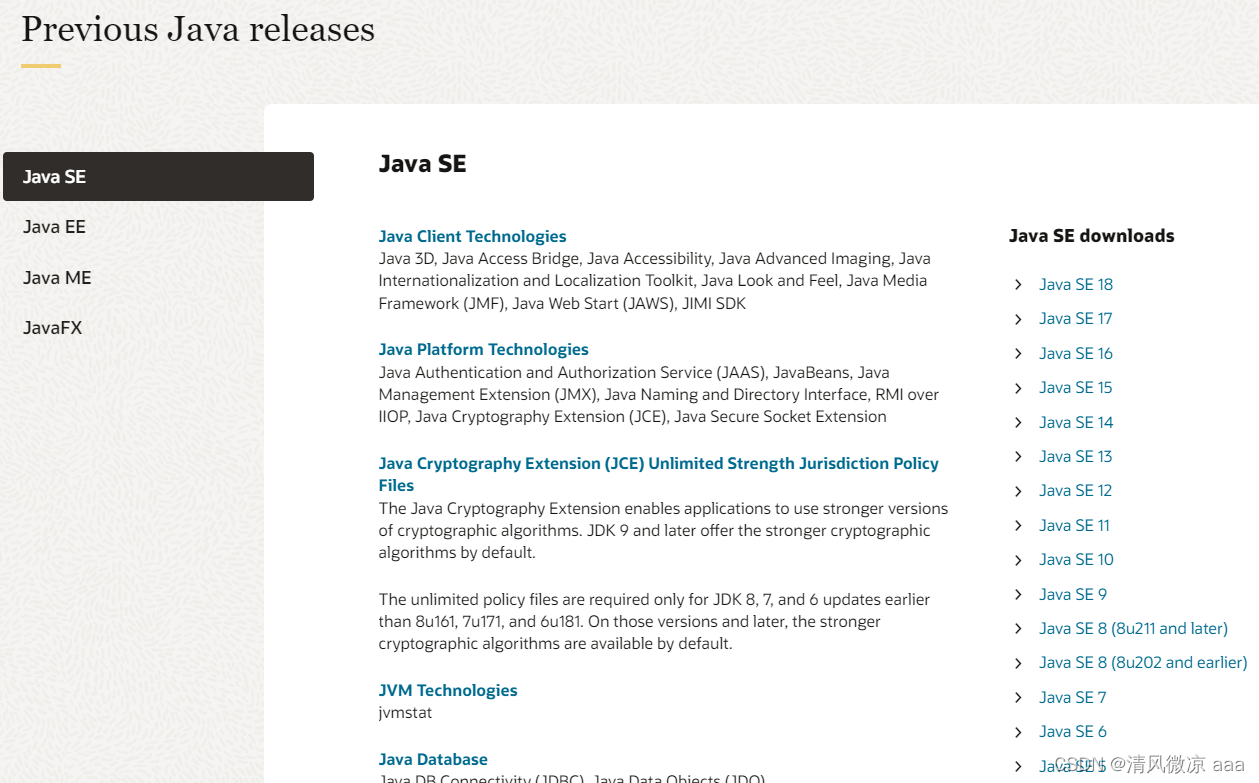
链接:https://pan.baidu.com/s/15QrBUOvfE9vjlTzN_EeVLg
提取码:yyds
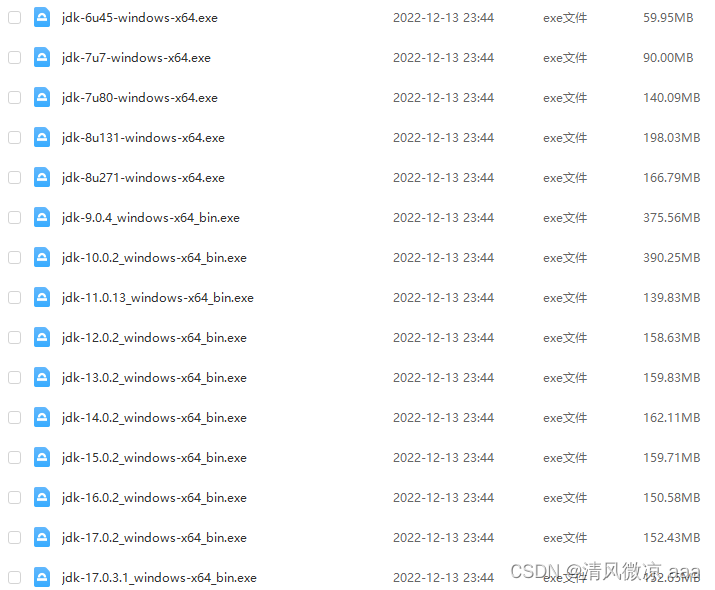
1.6 如何学习新特性
对于新特性,我们应该从哪几个角度学习新特性呢?
-
语法层面:
- 比如JDK5中的自动拆箱、自动装箱、enum、泛型
- 比如JDK8中的lambda表达式、接口中的默认方法、静态方法
- 比如JDK10中局部变量的类型推断
- 比如JDK12中的switch
- 比如JDK13中的文本块
-
API层面:
- 比如JDK8中的Stream、Optional、新的日期时间、HashMap的底层结构
- 比如JDK9中String的底层结构
- 新的 / 过时的 API
-
底层优化
-
比如JDK8中永久代被元空间替代、新的JS执行引擎
-
比如新的垃圾回收器、GC参数、JVM的优化
-
2. Java8新特性:Lambda表达式
2.1 关于Java8新特性简介
Java 8 (又称为 JDK 8或JDK1.8) 是 Java 语言开发的一个主要版本。 Java 8 是oracle公司于2014年3月发布,可以看成是自Java 5 以来最具革命性的版本。Java 8为Java语言、编译器、类库、开发工具与JVM带来了大量新特性。
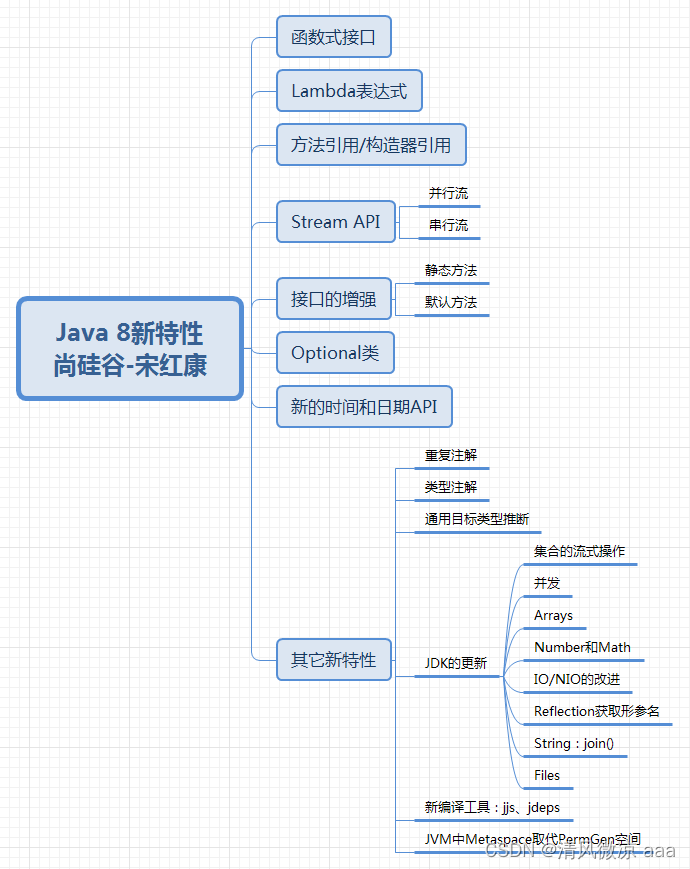
-
速度更快
-
代码更少(增加了新的语法:Lambda 表达式)
-
强大的 Stream API
-
便于并行
- 并行流就是把一个内容分成多个数据块,并用不同的线程分别处理每个数据块的流。相比较串行的流,并行的流可以很大程度上提高程序的执行效率。
- Java 8 中将并行进行了优化,我们可以很容易的对数据进行并行操作。Stream API 可以声明性地通过 parallel() 与 sequential() 在并行流与顺序流之间进行切换。
-
最大化减少空指针异常:Optional
-
Nashorn引擎,允许在JVM上运行JS应用
- 发音“nass-horn”,是德国二战时一个坦克的命名
- javascript运行在jvm已经不是新鲜事了,Rhino早在jdk6的时候已经存在。现在替代Rhino,官方的解释是Rhino相比其他JavaScript引擎(比如google的V8)实在太慢了,改造Rhino还不如重写。所以Nashorn的性能也是其一个亮点。
- Nashorn 项目在 JDK 9 中得到改进;在JDK11 中
Deprecated,后续JDK15版本中remove。在JDK11中取以代之的是GraalVM。(GraalVM是一个运行时平台,它支持Java和其他基于Java字节码的语言,但也支持其他语言,如JavaScript,Ruby,Python或LLVM。性能是Nashorn的2倍以上。)
2.2 冗余的匿名内部类
当需要启动一个线程去完成任务时,通常会通过java.lang.Runnable接口来定义任务内容,并使用java.lang.Thread类来启动该线程。代码如下:
package com.atguigu.fp;
public class UseFunctionalProgramming {
public static void main(String[] args) {
new Thread(new Runnable() {
@Override
public void run() {
System.out.println("多线程任务执行!");
}
}).start(); // 启动线程
}
}
本着“一切皆对象”的思想,这种做法是无可厚非的:首先创建一个Runnable接口的匿名内部类对象来指定任务内容,再将其交给一个线程来启动。
代码分析:
对于Runnable的匿名内部类用法,可以分析出几点内容:
Thread类需要Runnable接口作为参数,其中的抽象run方法是用来指定线程任务内容的核心;- 为了指定
run的方法体,不得不需要Runnable接口的实现类; - 为了省去定义一个
RunnableImpl实现类的麻烦,不得不使用匿名内部类; - 必须覆盖重写抽象
run方法,所以方法名称、方法参数、方法返回值不得不再写一遍,且不能写错; - 而实际上,似乎只有方法体才是关键所在。
2.3 好用的lambda表达式

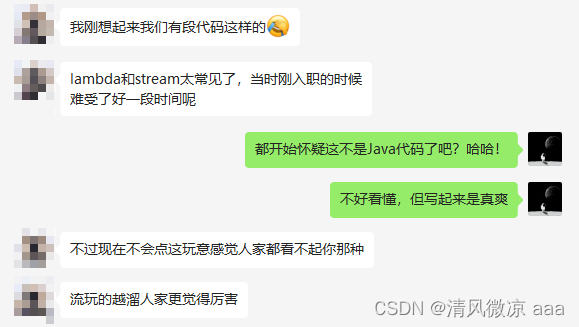
2.4 Lambda 及其使用举例
Lambda 是一个匿名函数,我们可以把 Lambda 表达式理解为是一段可以传递的代码(将代码像数据一样进行传递)。使用它可以写出更简洁、更灵活的代码。作为一种更紧凑的代码风格,使Java的语言表达能力得到了提升。
- 从匿名类到 Lambda 的转换举例1
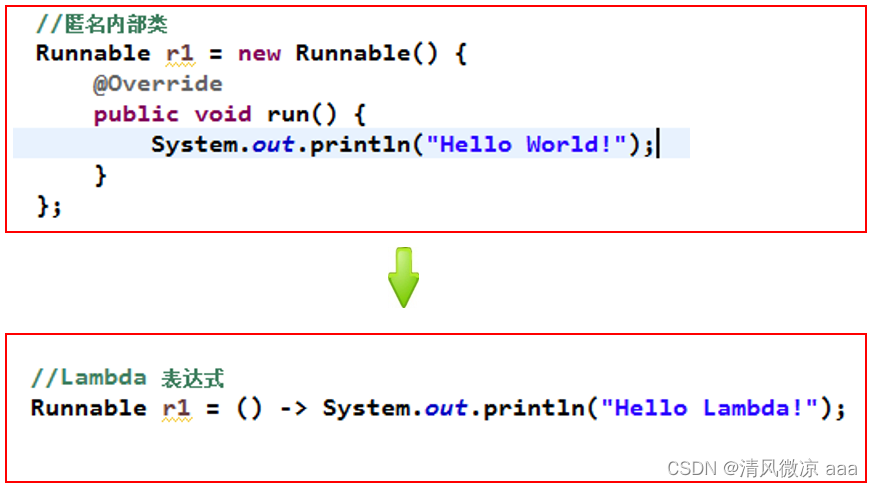
- 从匿名类到 Lambda 的转换举例2
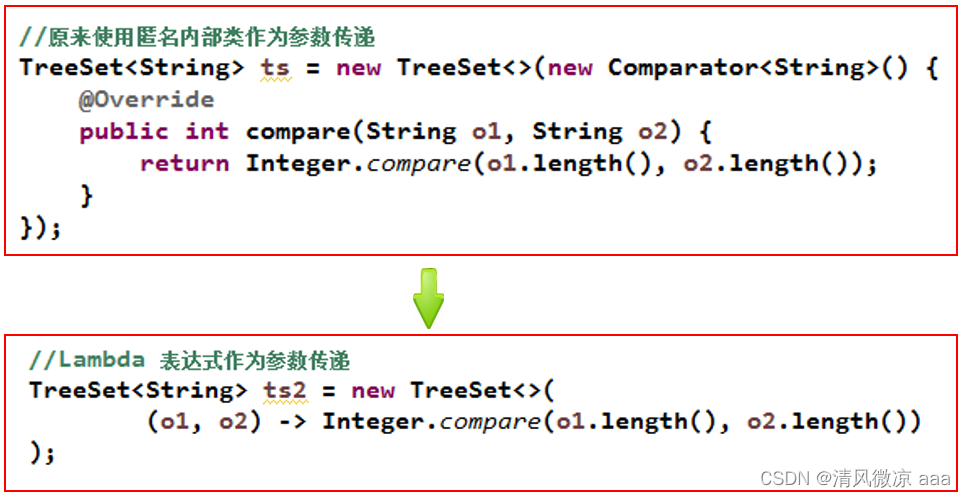
2.5 语法
Lambda 表达式:在Java 8 语言中引入的一种新的语法元素和操作符。这个操作符为 “->” , 该操作符被称为 Lambda 操作符或箭头操作符。它将 Lambda 分为两个部分:
- 左侧:指定了 Lambda 表达式需要的参数列表
- 右侧:指定了 Lambda 体,是抽象方法的实现逻辑,也即 Lambda 表达式要执行的功能。
**语法格式一:**无参,无返回值
@Test
public void test1(){
//未使用Lambda表达式
Runnable r1 = new Runnable() {
@Override
public void run() {
System.out.println("我爱北京天安门");
}
};
r1.run();
System.out.println("***********************");
//使用Lambda表达式
Runnable r2 = () -> {
System.out.println("我爱北京故宫");
};
r2.run();
}
语法格式二:Lambda 需要一个参数,但是没有返回值。
@Test
public void test2(){
//未使用Lambda表达式
Consumer<String> con = new Consumer<String>() {
@Override
public void accept(String s) {
System.out.println(s);
}
};
con.accept("谎言和誓言的区别是什么?");
System.out.println("*******************");
//使用Lambda表达式
Consumer<String> con1 = (String s) -> {
System.out.println(s);
};
con1.accept("一个是听得人当真了,一个是说的人当真了");
}
**语法格式三:**数据类型可以省略,因为可由编译器推断得出,称为“类型推断”
@Test
public void test3(){
//语法格式三使用前
Consumer<String> con1 = (String s) -> {
System.out.println(s);
};
con1.accept("一个是听得人当真了,一个是说的人当真了");
System.out.println("*******************");
//语法格式三使用后
Consumer<String> con2 = (s) -> {
System.out.println(s);
};
con2.accept("一个是听得人当真了,一个是说的人当真了");
}
语法格式四:Lambda 若只需要一个参数时,参数的小括号可以省略
@Test
public void test4(){
//语法格式四使用前
Consumer<String> con1 = (s) -> {
System.out.println(s);
};
con1.accept("一个是听得人当真了,一个是说的人当真了");
System.out.println("*******************");
//语法格式四使用后
Consumer<String> con2 = s -> {
System.out.println(s);
};
con2.accept("一个是听得人当真了,一个是说的人当真了");
}
语法格式五:Lambda 需要两个或以上的参数,多条执行语句,并且可以有返回值
@Test
public void test5(){
//语法格式五使用前
Comparator<Integer> com1 = new Comparator<Integer>() {
@Override
public int compare(Integer o1, Integer o2) {
System.out.println(o1);
System.out.println(o2);
return o1.compareTo(o2);
}
};
System.out.println(com1.compare(12,21));
System.out.println("*****************************");
//语法格式五使用后
Comparator<Integer> com2 = (o1,o2) -> {
System.out.println(o1);
System.out.println(o2);
return o1.compareTo(o2);
};
System.out.println(com2.compare(12,6));
}
语法格式六:当 Lambda 体只有一条语句时,return 与大括号若有,都可以省略
@Test
public void test6(){
//语法格式六使用前
Comparator<Integer> com1 = (o1,o2) -> {
return o1.compareTo(o2);
};
System.out.println(com1.compare(12,6));
System.out.println("*****************************");
//语法格式六使用后
Comparator<Integer> com2 = (o1,o2) -> o1.compareTo(o2);
System.out.println(com2.compare(12,21));
}
@Test
public void test7(){
//语法格式六使用前
Consumer<String> con1 = s -> {
System.out.println(s);
};
con1.accept("一个是听得人当真了,一个是说的人当真了");
System.out.println("*****************************");
//语法格式六使用后
Consumer<String> con2 = s -> System.out.println(s);
con2.accept("一个是听得人当真了,一个是说的人当真了");
}
2.6 关于类型推断
在语法格式三 Lambda 表达式中的参数类型都是由编译器推断得出的。Lambda 表达式中无需指定类型,程序依然可以编译,这是因为 javac 根据程序的上下文,在后台推断出了参数的类型。Lambda 表达式的类型依赖于上下文环境,是由编译器推断出来的。这就是所谓的“类型推断”。

举例:
@Test
public void test() {
//类型推断1
ArrayList<String> list = new ArrayList<>();
//类型推断2
int[] arr = {1, 2, 3};
}
3. Java8新特性:函数式(Functional)接口
3.1 什么是函数式接口
- 只包含
一个抽象方法(Single Abstract Method,简称SAM)的接口,称为函数式接口。当然该接口可以包含其他非抽象方法。 - 你可以通过 Lambda 表达式来创建该接口的对象。(若 Lambda 表达式抛出一个受检异常(即:非运行时异常),那么该异常需要在目标接口的抽象方法上进行声明)。
- 我们可以在一个接口上使用
@FunctionalInterface注解,这样做可以检查它是否是一个函数式接口。同时 javadoc 也会包含一条声明,说明这个接口是一个函数式接口。 - 在
java.util.function包下定义了Java 8 的丰富的函数式接口
3.2 如何理解函数式接口

- Java从诞生日起就是一直倡导“一切皆对象”,在Java里面面向对象(OOP)编程是一切。但是随着python、scala等语言的兴起和新技术的挑战,Java不得不做出调整以便支持更加广泛的技术要求,即Java不但可以支持OOP还可以支持OOF(面向函数编程)
- Java8引入了Lambda表达式之后,Java也开始支持函数式编程。
- Lambda表达式不是Java最早使用的。目前C++,C#,Python,Scala等均支持Lambda表达式。
- 面向对象的思想:
- 做一件事情,找一个能解决这个事情的对象,调用对象的方法,完成事情。
- 函数式编程思想:
- 只要能获取到结果,谁去做的,怎么做的都不重要,重视的是结果,不重视过程。
- 在函数式编程语言当中,函数被当做一等公民对待。在将函数作为一等公民的编程语言中,Lambda表达式的类型是函数。但是在Java8中,有所不同。在Java8中,Lambda表达式是对象,而不是函数,它们必须依附于一类特别的对象类型——函数式接口。
- 简单的说,在Java8中,Lambda表达式就是一个函数式接口的实例。这就是Lambda表达式和函数式接口的关系。也就是说,只要一个对象是函数式接口的实例,那么该对象就可以用Lambda表达式来表示。
3.3 举例
举例1:
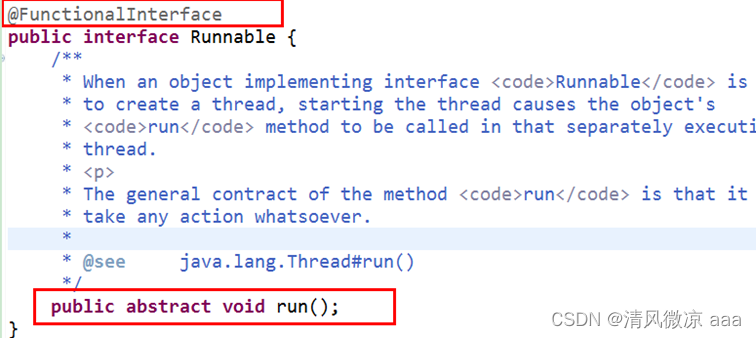
举例2:

作为参数传递 Lambda 表达式:
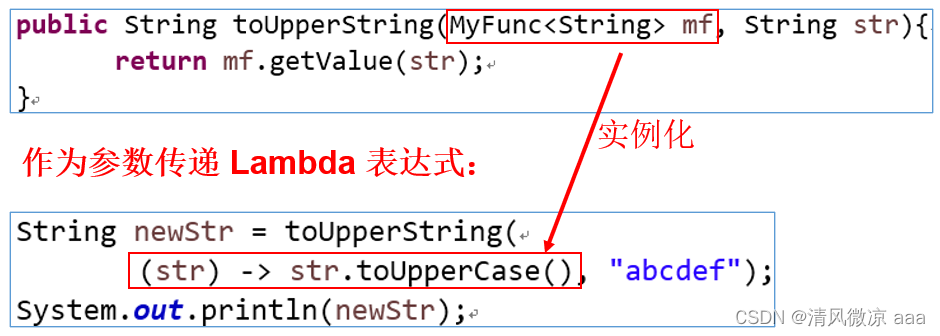
作为参数传递 Lambda 表达式:为了将 Lambda 表达式作为参数传递,接收Lambda 表达式的参数类型必须是与该 Lambda 表达式兼容的函数式接口的类型。
3.4 Java 内置函数式接口
3.4.1 之前的函数式接口
之前学过的接口,有些就是函数式接口,比如:
- java.lang.Runnable
- public void run()
- java.lang.Iterable
- public Iterator iterate()
- java.lang.Comparable
- public int compareTo(T t)
- java.util.Comparator
- public int compare(T t1, T t2)
3.4.2 四大核心函数式接口
| 函数式接口 | 称谓 | 参数类型 | 用途 |
|---|---|---|---|
Consumer<T> | 消费型接口 | T | 对类型为T的对象应用操作,包含方法: void accept(T t) |
Supplier<T> | 供给型接口 | 无 | 返回类型为T的对象,包含方法:T get() |
Function<T, R> | 函数型接口 | T | 对类型为T的对象应用操作,并返回结果。结果是R类型的对象。包含方法:R apply(T t) |
Predicate<T> | 判断型接口 | T | 确定类型为T的对象是否满足某约束,并返回 boolean 值。包含方法:boolean test(T t) |
3.4.3 其它接口
类型1:消费型接口
消费型接口的抽象方法特点:有形参,但是返回值类型是void
| 接口名 | 抽象方法 | 描述 |
|---|---|---|
| BiConsumer<T,U> | void accept(T t, U u) | 接收两个对象用于完成功能 |
| DoubleConsumer | void accept(double value) | 接收一个double值 |
| IntConsumer | void accept(int value) | 接收一个int值 |
| LongConsumer | void accept(long value) | 接收一个long值 |
| ObjDoubleConsumer | void accept(T t, double value) | 接收一个对象和一个double值 |
| ObjIntConsumer | void accept(T t, int value) | 接收一个对象和一个int值 |
| ObjLongConsumer | void accept(T t, long value) | 接收一个对象和一个long值 |
类型2:供给型接口
这类接口的抽象方法特点:无参,但是有返回值
| 接口名 | 抽象方法 | 描述 |
|---|---|---|
| BooleanSupplier | boolean getAsBoolean() | 返回一个boolean值 |
| DoubleSupplier | double getAsDouble() | 返回一个double值 |
| IntSupplier | int getAsInt() | 返回一个int值 |
| LongSupplier | long getAsLong() | 返回一个long值 |
类型3:函数型接口
这类接口的抽象方法特点:既有参数又有返回值
| 接口名 | 抽象方法 | 描述 |
|---|---|---|
| UnaryOperator | T apply(T t) | 接收一个T类型对象,返回一个T类型对象结果 |
| DoubleFunction | R apply(double value) | 接收一个double值,返回一个R类型对象 |
| IntFunction | R apply(int value) | 接收一个int值,返回一个R类型对象 |
| LongFunction | R apply(long value) | 接收一个long值,返回一个R类型对象 |
| ToDoubleFunction | double applyAsDouble(T value) | 接收一个T类型对象,返回一个double |
| ToIntFunction | int applyAsInt(T value) | 接收一个T类型对象,返回一个int |
| ToLongFunction | long applyAsLong(T value) | 接收一个T类型对象,返回一个long |
| DoubleToIntFunction | int applyAsInt(double value) | 接收一个double值,返回一个int结果 |
| DoubleToLongFunction | long applyAsLong(double value) | 接收一个double值,返回一个long结果 |
| IntToDoubleFunction | double applyAsDouble(int value) | 接收一个int值,返回一个double结果 |
| IntToLongFunction | long applyAsLong(int value) | 接收一个int值,返回一个long结果 |
| LongToDoubleFunction | double applyAsDouble(long value) | 接收一个long值,返回一个double结果 |
| LongToIntFunction | int applyAsInt(long value) | 接收一个long值,返回一个int结果 |
| DoubleUnaryOperator | double applyAsDouble(double operand) | 接收一个double值,返回一个double |
| IntUnaryOperator | int applyAsInt(int operand) | 接收一个int值,返回一个int结果 |
| LongUnaryOperator | long applyAsLong(long operand) | 接收一个long值,返回一个long结果 |
| BiFunction<T,U,R> | R apply(T t, U u) | 接收一个T类型和一个U类型对象,返回一个R类型对象结果 |
| BinaryOperator | T apply(T t, T u) | 接收两个T类型对象,返回一个T类型对象结果 |
| ToDoubleBiFunction<T,U> | double applyAsDouble(T t, U u) | 接收一个T类型和一个U类型对象,返回一个double |
| ToIntBiFunction<T,U> | int applyAsInt(T t, U u) | 接收一个T类型和一个U类型对象,返回一个int |
| ToLongBiFunction<T,U> | long applyAsLong(T t, U u) | 接收一个T类型和一个U类型对象,返回一个long |
| DoubleBinaryOperator | double applyAsDouble(double left, double right) | 接收两个double值,返回一个double结果 |
| IntBinaryOperator | int applyAsInt(int left, int right) | 接收两个int值,返回一个int结果 |
| LongBinaryOperator | long applyAsLong(long left, long right) | 接收两个long值,返回一个long结果 |
类型4:判断型接口
这类接口的抽象方法特点:有参,但是返回值类型是boolean结果。
| 接口名 | 抽象方法 | 描述 |
|---|---|---|
| BiPredicate<T,U> | boolean test(T t, U u) | 接收两个对象 |
| DoublePredicate | boolean test(double value) | 接收一个double值 |
| IntPredicate | boolean test(int value) | 接收一个int值 |
| LongPredicate | boolean test(long value) | 接收一个long值 |
3.4.4 内置接口代码演示
举例1:
package com.atguigu.four;
import java.util.Arrays;
import java.util.List;
public class TestConsumer {
public static void main(String[] args) {
List<String> list = Arrays.asList("java","c","python","c++","VB","C#");
//遍历Collection集合,并将传递给action参数的操作代码应用在每一个元素上。
list.forEach(s -> System.out.println(s));
}
}
举例2:
package com.atguigu.four;
import java.util.function.Supplier;
public class TestSupplier {
public static void main(String[] args) {
Supplier<String> supplier = () -> "尚硅谷";
System.out.println(supplier.get());
}
}
举例3:
package com.atguigu.four;
import java.util.ArrayList;
public class TestPredicate {
public static void main(String[] args) {
ArrayList<String> list = new ArrayList<>();
list.add("hello");
list.add("java");
list.add("atguigu");
list.add("ok");
list.add("yes");
System.out.println("删除之前:");
list.forEach(t-> System.out.println(t));
//用于删除集合中满足filter指定的条件判断的。
//删除包含o字母的元素
list.removeIf(s -> s.contains("o"));
System.out.println("删除包含o字母的元素之后:");
list.forEach(t-> System.out.println(t));
}
}
举例4:
package com.atguigu.four;
import java.util.function.Function;
public class TestFunction {
public static void main(String[] args) {
//使用Lambda表达式实现Function<T,R>接口,可以实现将一个字符串首字母转为大写的功能。
Function<String,String> fun = s -> s.substring(0,1).toUpperCase() + s.substring(1);
System.out.println(fun.apply("hello"));
}
}
3.4.5 练习
练习1:无参无返回值形式
假如有自定义函数式接口Call如下:
public interface Call {
void shout();
}
在测试类中声明一个如下方法:
public static void callSomething(Call call){
call.shout();
}
在测试类的main方法中调用callSomething方法,并用Lambda表达式为形参call赋值,可以喊出任意你想说的话。
public class TestLambda {
public static void main(String[] args) {
callSomething(()->System.out.println("回家吃饭"));
callSomething(()->System.out.println("我爱你"));
callSomething(()->System.out.println("滚蛋"));
callSomething(()->System.out.println("回来"));
}
public static void callSomething(Call call){
call.shout();
}
}
interface Call {
void shout();
}
练习2:消费型接口
代码示例:Consumer接口
在JDK1.8中Collection集合接口的父接口Iterable接口中增加了一个默认方法:
public default void forEach(Consumer<? super T> action) 遍历Collection集合的每个元素,执行“xxx消费型”操作。
在JDK1.8中Map集合接口中增加了一个默认方法:
public default void forEach(BiConsumer<? super K,? super V> action)遍历Map集合的每对映射关系,执行“xxx消费型”操作。
案例:
(1)创建一个Collection系列的集合,添加一些字符串,调用forEach方法遍历查看
(2)创建一个Map系列的集合,添加一些(key,value)键值对,调用forEach方法遍历查看
示例代码:
@Test
public void test1(){
List<String> list = Arrays.asList("hello","java","lambda","atguigu");
list.forEach(s -> System.out.println(s));
}
@Test
public void test2(){
HashMap<Integer,String> map = new HashMap<>();
map.put(1, "hello");
map.put(2, "java");
map.put(3, "lambda");
map.put(4, "atguigu");
map.forEach((k,v) -> System.out.println(k+"->"+v));
}
练习3:供给型接口
代码示例:Supplier接口
在JDK1.8中增加了StreamAPI,java.util.stream.Stream是一个数据流。这个类型有一个静态方法:
public static <T> Stream<T> generate(Supplier<T> s)可以创建Stream的对象。而又包含一个forEach方法可以遍历流中的元素:public void forEach(Consumer<? super T> action)。
案例:
现在请调用Stream的generate方法,来产生一个流对象,并调用Math.random()方法来产生数据,为Supplier函数式接口的形参赋值。最后调用forEach方法遍历流中的数据查看结果。
@Test
public void test2(){
Stream.generate(() -> Math.random()).forEach(num -> System.out.println(num));
}
练习4:功能型接口
代码示例:Function<T,R>接口
在JDK1.8时Map接口增加了很多方法,例如:
public default void replaceAll(BiFunction<? super K,? super V,? extends V> function) 按照function指定的操作替换map中的value。
public default void forEach(BiConsumer<? super K,? super V> action)遍历Map集合的每对映射关系,执行“xxx消费型”操作。
案例:
(1)声明一个Employee员工类型,包含编号、姓名、薪资。
(2)添加n个员工对象到一个HashMap<Integer,Employee>集合中,其中员工编号为key,员工对象为value。
(3)调用Map的forEach遍历集合
(4)调用Map的replaceAll方法,将其中薪资低于10000元的,薪资设置为10000。
(5)再次调用Map的forEach遍历集合查看结果
Employee类:
class Employee{
private int id;
private String name;
private double salary;
public Employee(int id, String name, double salary) {
super();
this.id = id;
this.name = name;
this.salary = salary;
}
public Employee() {
super();
}
public int getId() {
return id;
}
public void setId(int id) {
this.id = id;
}
public String getName() {
return name;
}
public void setName(String name) {
this.name = name;
}
public double getSalary() {
return salary;
}
public void setSalary(double salary) {
this.salary = salary;
}
@Override
public String toString() {
return "Employee [id=" + id + ", name=" + name + ", salary=" + salary + "]";
}
}
测试类:
import java.util.HashMap;
public class TestLambda {
public static void main(String[] args) {
HashMap<Integer,Employee> map = new HashMap<>();
Employee e1 = new Employee(1, "张三", 8000);
Employee e2 = new Employee(2, "李四", 9000);
Employee e3 = new Employee(3, "王五", 10000);
Employee e4 = new Employee(4, "赵六", 11000);
Employee e5 = new Employee(5, "钱七", 12000);
map.put(e1.getId(), e1);
map.put(e2.getId(), e2);
map.put(e3.getId(), e3);
map.put(e4.getId(), e4);
map.put(e5.getId(), e5);
map.forEach((k,v) -> System.out.println(k+"="+v));
System.out.println();
map.replaceAll((k,v)->{
if(v.getSalary()<10000){
v.setSalary(10000);
}
return v;
});
map.forEach((k,v) -> System.out.println(k+"="+v));
}
}
练习5:判断型接口
代码示例:Predicate接口
JDK1.8时,Collecton接口增加了一下方法,其中一个如下:
public default boolean removeIf(Predicate<? super E> filter) 用于删除集合中满足filter指定的条件判断的。
public default void forEach(Consumer<? super T> action) 遍历Collection集合的每个元素,执行“xxx消费型”操作。
案例:
(1)添加一些字符串到一个Collection集合中
(2)调用forEach遍历集合
(3)调用removeIf方法,删除其中字符串的长度<5的
(4)再次调用forEach遍历集合
import java.util.ArrayList;
public class TestLambda {
public static void main(String[] args) {
ArrayList<String> list = new ArrayList<>();
list.add("hello");
list.add("java");
list.add("atguigu");
list.add("ok");
list.add("yes");
list.forEach(str->System.out.println(str));
System.out.println();
list.removeIf(str->str.length()<5);
list.forEach(str->System.out.println(str));
}
}
练习6:判断型接口
案例:
(1)声明一个Employee员工类型,包含编号、姓名、性别,年龄,薪资。
(2)声明一个EmployeeSerice员工管理类,包含一个ArrayList集合的属性all,在EmployeeSerice的构造器中,创建一些员工对象,为all集合初始化。
(3)在EmployeeSerice员工管理类中,声明一个方法:ArrayList get(Predicate p),即将满足p指定的条件的员工,添加到一个新的ArrayList 集合中返回。
(4)在测试类中创建EmployeeSerice员工管理类的对象,并调用get方法,分别获取:
- 所有员工对象
- 所有年龄超过35的员工
- 所有薪资高于15000的女员工
- 所有编号是偶数的员工
- 名字是“张三”的员工
- 年龄超过25,薪资低于10000的男员工
示例代码:
Employee类:
public class Employee{
private int id;
private String name;
private char gender;
private int age;
private double salary;
public Employee(int id, String name, char gender, int age, double salary) {
super();
this.id = id;
this.name = name;
this.gender = gender;
this.age = age;
this.salary = salary;
}
public Employee() {
super();
}
public int getId() {
return id;
}
public void setId(int id) {
this.id = id;
}
public String getName() {
return name;
}
public void setName(String name) {
this.name = name;
}
public double getSalary() {
return salary;
}
public void setSalary(double salary) {
this.salary = salary;
}
@Override
public String toString() {
return "Employee [id=" + id + ", name=" + name + ", gender=" + gender + ", age=" + age + ", salary=" + salary
+ "]";
}
}
员工管理类:
class EmployeeService{
private ArrayList<Employee> all;
public EmployeeService(){
all = new ArrayList<Employee>();
all.add(new Employee(1, "张三", '男', 33, 8000));
all.add(new Employee(2, "翠花", '女', 23, 18000));
all.add(new Employee(3, "无能", '男', 46, 8000));
all.add(new Employee(4, "李四", '女', 23, 9000));
all.add(new Employee(5, "老王", '男', 23, 15000));
all.add(new Employee(6, "大嘴", '男', 23, 11000));
}
public ArrayList<Employee> get(Predicate<Employee> p){
ArrayList<Employee> result = new ArrayList<Employee>();
for (Employee emp : result) {
if(p.test(emp)){
result.add(emp);
}
}
return result;
}
}
测试类:
public class TestLambda {
public static void main(String[] args) {
EmployeeService es = new EmployeeService();
es.get(e -> true).forEach(e->System.out.println(e));
System.out.println();
es.get(e -> e.getAge()>35).forEach(e->System.out.println(e));
System.out.println();
es.get(e -> e.getSalary()>15000 && e.getGender()=='女').forEach(e->System.out.println(e));
System.out.println();
es.get(e -> e.getId()%2==0).forEach(e->System.out.println(e));
System.out.println();
es.get(e -> "张三".equals(e.getName())).forEach(e->System.out.println(e));
System.out.println();
es.get(e -> e.getAge()>25 && e.getSalary()<10000 && e.getGender()=='男').forEach(e->System.out.println(e));
}
}
4. Java8新特性:方法引用与构造器引用
Lambda表达式是可以简化函数式接口的变量或形参赋值的语法。而方法引用和构造器引用是为了简化Lambda表达式的。
4.1 方法引用
当要传递给Lambda体的操作,已经有实现的方法了,可以使用方法引用!
方法引用可以看做是Lambda表达式深层次的表达。换句话说,方法引用就是Lambda表达式,也就是函数式接口的一个实例,通过方法的名字来指向一个方法,可以认为是Lambda表达式的一个语法糖。
语法糖(Syntactic sugar),也译为糖衣语法,是由英国计算机科学家彼得·约翰·兰达(Peter J. Landin)发明的一个术语,指计算机语言中添加的某种语法,这种语法
对语言的功能并没有影响,但是更方便程序员使用。通常来说使用语法糖能够增加程序的可读性,从而减少程序代码出错的机会。
4.1.1 方法引用格式
-
格式:使用方法引用操作符 “
::” 将类(或对象) 与 方法名分隔开来。- 两个:中间不能有空格,而且必须英文状态下半角输入
-
如下三种主要使用情况:
- 情况1:
对象 :: 实例方法名 - 情况2:
类 :: 静态方法名 - 情况3:
类 :: 实例方法名
- 情况1:
4.1.2 方法引用使用前提
**要求1:**Lambda体只有一句语句,并且是通过调用一个对象的/类现有的方法来完成的
例如:System.out对象,调用println()方法来完成Lambda体
? Math类,调用random()静态方法来完成Lambda体
要求2:
针对情况1:函数式接口中的抽象方法a在被重写时使用了某一个对象的方法b。如果方法a的形参列表、返回值类型与方法b的形参列表、返回值类型都相同,则我们可以使用方法b实现对方法a的重写、替换。
针对情况2:函数式接口中的抽象方法a在被重写时使用了某一个类的静态方法b。如果方法a的形参列表、返回值类型与方法b的形参列表、返回值类型都相同,则我们可以使用方法b实现对方法a的重写、替换。
针对情况3:函数式接口中的抽象方法a在被重写时使用了某一个对象的方法b。如果方法a的返回值类型与方法b的返回值类型相同,同时方法a的形参列表中有n个参数,方法b的形参列表有n-1个参数,且方法a的第1个参数作为方法b的调用者,且方法a的后n-1参数与方法b的n-1参数匹配(类型相同或满足多态场景也可以)
例如:t->System.out.println(t)
? () -> Math.random() 都是无参
4.1.3 举例
public class MethodRefTest {
// 情况一:对象 :: 实例方法
//Consumer中的void accept(T t)
//PrintStream中的void println(T t)
@Test
public void test1() {
Consumer<String> con1 = str -> System.out.println(str);
con1.accept("北京");
System.out.println("*******************");
PrintStream ps = System.out;
Consumer<String> con2 = ps::println;
con2.accept("beijing");
}
//Supplier中的T get()
//Employee中的String getName()
@Test
public void test2() {
Employee emp = new Employee(1001,"Tom",23,5600);
Supplier<String> sup1 = () -> emp.getName();
System.out.println(sup1.get());
System.out.println("*******************");
Supplier<String> sup2 = emp::getName;
System.out.println(sup2.get());
}
// 情况二:类 :: 静态方法
//Comparator中的int compare(T t1,T t2)
//Integer中的int compare(T t1,T t2)
@Test
public void test3() {
Comparator<Integer> com1 = (t1,t2) -> Integer.compare(t1,t2);
System.out.println(com1.compare(12,21));
System.out.println("*******************");
Comparator<Integer> com2 = Integer::compare;
System.out.println(com2.compare(12,3));
}
//Function中的R apply(T t)
//Math中的Long round(Double d)
@Test
public void test4() {
Function<Double,Long> func = new Function<Double, Long>() {
@Override
public Long apply(Double d) {
return Math.round(d);
}
};
System.out.println("*******************");
Function<Double,Long> func1 = d -> Math.round(d);
System.out.println(func1.apply(12.3));
System.out.println("*******************");
Function<Double,Long> func2 = Math::round;
System.out.println(func2.apply(12.6));
}
// 情况三:类 :: 实例方法 (有难度)
// Comparator中的int comapre(T t1,T t2)
// String中的int t1.compareTo(t2)
@Test
public void test5() {
Comparator<String> com1 = (s1,s2) -> s1.compareTo(s2);
System.out.println(com1.compare("abc","abd"));
System.out.println("*******************");
Comparator<String> com2 = String :: compareTo;
System.out.println(com2.compare("abd","abm"));
}
//BiPredicate中的boolean test(T t1, T t2);
//String中的boolean t1.equals(t2)
@Test
public void test6() {
BiPredicate<String,String> pre1 = (s1,s2) -> s1.equals(s2);
System.out.println(pre1.test("abc","abc"));
System.out.println("*******************");
BiPredicate<String,String> pre2 = String :: equals;
System.out.println(pre2.test("abc","abd"));
}
// Function中的R apply(T t)
// Employee中的String getName();
@Test
public void test7() {
Employee employee = new Employee(1001, "Jerry", 23, 6000);
Function<Employee,String> func1 = e -> e.getName();
System.out.println(func1.apply(employee));
System.out.println("*******************");
Function<Employee,String> func2 = Employee::getName;
System.out.println(func2.apply(employee));
}
}
4.2 构造器引用
当Lambda表达式是创建一个对象,并且满足Lambda表达式形参,正好是给创建这个对象的构造器的实参列表,就可以使用构造器引用。
格式:类名::new
举例:
public class ConstructorRefTest {
//构造器引用
//Supplier中的T get()
//Employee的空参构造器:Employee()
@Test
public void test1(){
Supplier<Employee> sup = new Supplier<Employee>() {
@Override
public Employee get() {
return new Employee();
}
};
System.out.println("*******************");
Supplier<Employee> sup1 = () -> new Employee();
System.out.println(sup1.get());
System.out.println("*******************");
Supplier<Employee> sup2 = Employee :: new;
System.out.println(sup2.get());
}
//Function中的R apply(T t)
@Test
public void test2(){
Function<Integer,Employee> func1 = id -> new Employee(id);
Employee employee = func1.apply(1001);
System.out.println(employee);
System.out.println("*******************");
Function<Integer,Employee> func2 = Employee :: new;
Employee employee1 = func2.apply(1002);
System.out.println(employee1);
}
//BiFunction中的R apply(T t,U u)
@Test
public void test3(){
BiFunction<Integer,String,Employee> func1 = (id,name) -> new Employee(id,name);
System.out.println(func1.apply(1001,"Tom"));
System.out.println("*******************");
BiFunction<Integer,String,Employee> func2 = Employee :: new;
System.out.println(func2.apply(1002,"Tom"));
}
}
package com.atguigu.java2;
/**
* @author 尚硅谷-宋红康 邮箱:shkstart@126.com
*/
public class Employee {
private int id;
private String name;
private int age;
private double salary;
public int getId() {
return id;
}
public void setId(int id) {
this.id = id;
}
public String getName() {
return name;
}
public void setName(String name) {
this.name = name;
}
public int getAge() {
return age;
}
public void setAge(int age) {
this.age = age;
}
public double getSalary() {
return salary;
}
public void setSalary(double salary) {
this.salary = salary;
}
public Employee() {
System.out.println("Employee().....");
}
public Employee(int id) {
this.id = id;
System.out.println("Employee(int id).....");
}
public Employee(int id, String name) {
this.id = id;
this.name = name;
}
public Employee(int id, String name, int age, double salary) {
this.id = id;
this.name = name;
this.age = age;
this.salary = salary;
}
@Override
public String toString() {
return "Employee{" + "id=" + id + ", name='" + name + '\'' + ", age=" + age + ", salary=" + salary + '}';
}
}
4.3 数组构造引用
当Lambda表达式是创建一个数组对象,并且满足Lambda表达式形参,正好是给创建这个数组对象的长度,就可以数组构造引用。
格式:数组类型名::new
举例:
//数组引用
//Function中的R apply(T t)
@Test
public void test4(){
Function<Integer,String[]> func1 = length -> new String[length];
String[] arr1 = func1.apply(5);
System.out.println(Arrays.toString(arr1));
System.out.println("*******************");
Function<Integer,String[]> func2 = String[] :: new;
String[] arr2 = func2.apply(10);
System.out.println(Arrays.toString(arr2));
}
5. Java8新特性:强大的Stream API
5.1 说明
- Java8中有两大最为重要的改变。第一个是 Lambda 表达式;另外一个则是 Stream API。
- Stream API ( java.util.stream) 把真正的函数式编程风格引入到Java中。这是目前为止对Java类库
最好的补充,因为Stream API可以极大提供Java程序员的生产力,让程序员写出高效率、干净、简洁的代码。 - Stream 是 Java8 中处理集合的关键抽象概念,它可以指定你希望对集合进行的操作,可以执行非常复杂的查找、过滤和映射数据等操作。 **使用Stream API 对集合数据进行操作,就类似于使用 SQL 执行的数据库查询。**也可以使用 Stream API 来并行执行操作。简言之,Stream API 提供了一种高效且易于使用的处理数据的方式。
5.2 为什么要使用Stream API
实际开发中,项目中多数数据源都来自于MySQL、Oracle等。但现在数据源可以更多了,有MongDB,Radis等,而这些NoSQL的数据就需要Java层面去处理。
5.3 什么是Stream
Stream 是数据渠道,用于操作数据源(集合、数组等)所生成的元素序列。
Stream 和 Collection 集合的区别:**Collection 是一种静态的内存数据结构,讲的是数据,而 Stream 是有关计算的,讲的是计算。**前者是主要面向内存,存储在内存中,后者主要是面向 CPU,通过 CPU 实现计算。
注意:
①Stream 自己不会存储元素。
②Stream 不会改变源对象。相反,他们会返回一个持有结果的新Stream。
③Stream 操作是延迟执行的。这意味着他们会等到需要结果的时候才执行。即一旦执行终止操作,就执行中间操作链,并产生结果。
④ Stream一旦执行了终止操作,就不能再调用其它中间操作或终止操作了。
5.4 Stream的操作三个步骤
1- 创建 Stream
一个数据源(如:集合、数组),获取一个流
2- 中间操作
每次处理都会返回一个持有结果的新Stream,即中间操作的方法返回值仍然是Stream类型的对象。因此中间操作可以是个操作链,可对数据源的数据进行n次处理,但是在终结操作前,并不会真正执行。
3- 终止操作(终端操作)
终止操作的方法返回值类型就不再是Stream了,因此一旦执行终止操作,就结束整个Stream操作了。一旦执行终止操作,就执行中间操作链,最终产生结果并结束Stream。

5.4.1 创建Stream实例
方式一:通过集合
Java8 中的 Collection 接口被扩展,提供了两个获取流的方法:
-
default Stream stream() : 返回一个顺序流
-
default Stream parallelStream() : 返回一个并行流
@Test
public void test01(){
List<Integer> list = Arrays.asList(1,2,3,4,5);
//JDK1.8中,Collection系列集合增加了方法
Stream<Integer> stream = list.stream();
}
方式二:通过数组
Java8 中的 Arrays 的静态方法 stream() 可以获取数组流:
- static Stream stream(T[] array): 返回一个流
- public static IntStream stream(int[] array)
- public static LongStream stream(long[] array)
- public static DoubleStream stream(double[] array)
@Test
public void test02(){
String[] arr = {"hello","world"};
Stream<String> stream = Arrays.stream(arr);
}
@Test
public void test03(){
int[] arr = {1,2,3,4,5};
IntStream stream = Arrays.stream(arr);
}
方式三:通过Stream的of()
可以调用Stream类静态方法 of(), 通过显示值创建一个流。它可以接收任意数量的参数。
- public static Stream of(T… values) : 返回一个流
@Test
public void test04(){
Stream<Integer> stream = Stream.of(1,2,3,4,5);
stream.forEach(System.out::println);
}
方式四:创建无限流(了解)
可以使用静态方法 Stream.iterate() 和 Stream.generate(), 创建无限流。
-
迭代
public static Stream iterate(final T seed, final UnaryOperator f) -
生成
public static Stream generate(Supplier s)
// 方式四:创建无限流
@Test
public void test05() {
// 迭代
// public static<T> Stream<T> iterate(final T seed, final
// UnaryOperator<T> f)
Stream<Integer> stream = Stream.iterate(0, x -> x + 2);
stream.limit(10).forEach(System.out::println);
// 生成
// public static<T> Stream<T> generate(Supplier<T> s)
Stream<Double> stream1 = Stream.generate(Math::random);
stream1.limit(10).forEach(System.out::println);
}
5.4.2 一系列中间操作
多个中间操作可以连接起来形成一个流水线,除非流水线上触发终止操作,否则中间操作不会执行任何的处理!而在终止操作时一次性全部处理,称为“惰性求值”。
1-筛选与切片
| 方 法 | 描 述 |
|---|---|
| filter(Predicatep) | 接收 Lambda , 从流中排除某些元素 |
| distinct() | 筛选,通过流所生成元素的 hashCode() 和 equals() 去除重复元素 |
| limit(long maxSize) | 截断流,使其元素不超过给定数量 |
| skip(long n) | 跳过元素,返回一个扔掉了前 n 个元素的流。 若流中元素不足 n 个,则返回一个空流。与 limit(n) 互补 |
2-映 射
| 方法 | 描述 |
|---|---|
| map(Function f) | 接收一个函数作为参数,该函数会被应用到每个元素上,并将其映射成一个新的元素。 |
| mapToDouble(ToDoubleFunction f) | 接收一个函数作为参数,该函数会被应用到每个元素上,产生一个新的 DoubleStream。 |
| mapToInt(ToIntFunction f) | 接收一个函数作为参数,该函数会被应用到每个元素上,产生一个新的 IntStream。 |
| mapToLong(ToLongFunction f) | 接收一个函数作为参数,该函数会被应用到每个元素上,产生一个新的 LongStream。 |
| flatMap(Function f) | 接收一个函数作为参数,将流中的每个值都换成另一个流,然后把所有流连接成一个流 |
3-排序
| 方法 | 描述 |
|---|---|
| sorted() | 产生一个新流,其中按自然顺序排序 |
| sorted(Comparator com) | 产生一个新流,其中按比较器顺序排序 |
代码举例:
package com.atguigu.stream;
import org.junit.Test;
import java.util.Arrays;
import java.util.stream.Stream;
public class StreamMiddleOperate {
@Test
public void test01(){
//1、创建Stream
Stream<Integer> stream = Stream.of(1,2,3,4,5,6);
//2、加工处理
//过滤:filter(Predicate p)
//把里面的偶数拿出来
/*
* filter(Predicate p)
* Predicate是函数式接口,抽象方法:boolean test(T t)
*/
stream = stream.filter(t -> t%2==0);
//3、终结操作:例如:遍历
stream.forEach(System.out::println);
}
@Test
public void test02(){
Stream.of(1,2,3,4,5,6)
.filter(t -> t%2==0)
.forEach(System.out::println);
}
@Test
public void test03(){
Stream.of(1,2,3,4,5,6,2,2,3,3,4,4,5)
.distinct()
.forEach(System.out::println);
}
@Test
public void test04(){
Stream.of(1,2,3,4,5,6,2,2,3,3,4,4,5)
.limit(3)
.forEach(System.out::println);
}
@Test
public void test05(){
Stream.of(1,2,2,3,3,4,4,5,2,3,4,5,6,7)
.distinct() //(1,2,3,4,5,6,7)
.filter(t -> t%2!=0) //(1,3,5,7)
.limit(3)
.forEach(System.out::println);
}
@Test
public void test06(){
Stream.of(1,2,3,4,5,6,2,2,3,3,4,4,5)
.skip(5)
.forEach(System.out::println);
}
@Test
public void test07(){
Stream.of(1,2,3,4,5,6,2,2,3,3,4,4,5)
.skip(5)
.distinct()
.filter(t -> t%3==0)
.forEach(System.out::println);
}
@Test
public void test08(){
long count = Stream.of(1,2,3,4,5,6,2,2,3,3,4,4,5)
.distinct()
.peek(System.out::println) //Consumer接口的抽象方法 void accept(T t)
.count();
System.out.println("count="+count);
}
@Test
public void test09(){
//希望能够找出前三个最大值,前三名最大的,不重复
Stream.of(11,2,39,4,54,6,2,22,3,3,4,54,54)
.distinct()
.sorted((t1,t2) -> -Integer.compare(t1, t2))//Comparator接口 int compare(T t1, T t2)
.limit(3)
.forEach(System.out::println);
}
@Test
public void test10(){
Stream.of(1,2,3,4,5)
.map(t -> t+=1)//Function<T,R>接口抽象方法 R apply(T t)
.forEach(System.out::println);
}
@Test
public void test11(){
String[] arr = {"hello","world","java"};
Arrays.stream(arr)
.map(t->t.toUpperCase())
.forEach(System.out::println);
}
@Test
public void test12(){
String[] arr = {"hello","world","java"};
Arrays.stream(arr)
.flatMap(t -> Stream.of(t.split("|")))//Function<T,R>接口抽象方法 R apply(T t) 现在的R是一个Stream
.forEach(System.out::println);
}
}
5.4.3 终止操作
-
终端操作会从流的流水线生成结果。其结果可以是任何不是流的值,例如:List、Integer,甚至是 void 。
-
流进行了终止操作后,不能再次使用。
1-匹配与查找
| 方法 | 描述 |
|---|---|
| allMatch(Predicate p) | 检查是否匹配所有元素 |
| **anyMatch(Predicate p) ** | 检查是否至少匹配一个元素 |
| noneMatch(Predicate p) | 检查是否没有匹配所有元素 |
| findFirst() | 返回第一个元素 |
| findAny() | 返回当前流中的任意元素 |
| count() | 返回流中元素总数 |
| max(Comparator c) | 返回流中最大值 |
| min(Comparator c) | 返回流中最小值 |
| forEach(Consumer c) | 内部迭代(使用 Collection 接口需要用户去做迭代,称为外部迭代。 相反,Stream API 使用内部迭代——它帮你把迭代做了) |
2-归约
| 方法 | 描述 |
|---|---|
| reduce(T identity, BinaryOperator b) | 可以将流中元素反复结合起来,得到一个值。返回 T |
| reduce(BinaryOperator b) | 可以将流中元素反复结合起来,得到一个值。返回 Optional |
备注:map 和 reduce 的连接通常称为 map-reduce 模式,因 Google 用它来进行网络搜索而出名。
3-收集
| 方 法 | 描 述 |
|---|---|
| collect(Collector c) | 将流转换为其他形式。接收一个 Collector接口的实现, 用于给Stream中元素做汇总的方法 |
Collector 接口中方法的实现决定了如何对流执行收集的操作(如收集到 List、Set、Map)。
另外, Collectors 实用类提供了很多静态方法,可以方便地创建常见收集器实例,具体方法与实例如下表:
| 方法 | 返回类型 | 作用 |
|---|---|---|
| toList | Collector<T, ?, List> | 把流中元素收集到List |
List<Employee> emps= list.stream().collect(Collectors.toList());
| 方法 | 返回类型 | 作用 |
|---|---|---|
| toSet | Collector<T, ?, Set> | 把流中元素收集到Set |
Set<Employee> emps= list.stream().collect(Collectors.toSet());
| 方法 | 返回类型 | 作用 |
|---|---|---|
| toCollection | Collector<T, ?, C> | 把流中元素收集到创建的集合 |
Collection<Employee> emps =list.stream().collect(Collectors.toCollection(ArrayList::new));
| 方法 | 返回类型 | 作用 |
|---|---|---|
| counting | Collector<T, ?, Long> | 计算流中元素的个数 |
long count = list.stream().collect(Collectors.counting());
| 方法 | 返回类型 | 作用 |
|---|---|---|
| summingInt | Collector<T, ?, Integer> | 对流中元素的整数属性求和 |
int total=list.stream().collect(Collectors.summingInt(Employee::getSalary));
| 方法 | 返回类型 | 作用 |
|---|---|---|
| averagingInt | Collector<T, ?, Double> | 计算流中元素Integer属性的平均值 |
double avg = list.stream().collect(Collectors.averagingInt(Employee::getSalary));
| 方法 | 返回类型 | 作用 |
|---|---|---|
| summarizingInt | Collector<T, ?, IntSummaryStatistics> | 收集流中Integer属性的统计值。如:平均值 |
int SummaryStatisticsiss= list.stream().collect(Collectors.summarizingInt(Employee::getSalary));
| 方法 | 返回类型 | 作用 |
|---|---|---|
| joining | Collector<CharSequence, ?, String> | 连接流中每个字符串 |
String str= list.stream().map(Employee::getName).collect(Collectors.joining());
| 方法 | 返回类型 | 作用 |
|---|---|---|
| maxBy | Collector<T, ?, Optional> | 根据比较器选择最大值 |
Optional<Emp>max= list.stream().collect(Collectors.maxBy(comparingInt(Employee::getSalary)));
| 方法 | 返回类型 | 作用 |
|---|---|---|
| minBy | Collector<T, ?, Optional> | 根据比较器选择最小值 |
Optional<Emp> min = list.stream().collect(Collectors.minBy(comparingInt(Employee::getSalary)));
| 方法 | 返回类型 | 作用 |
|---|---|---|
| reducing | Collector<T, ?, Optional> | 从一个作为累加器的初始值开始,利用BinaryOperator与流中元素逐个结合,从而归约成单个值 |
int total=list.stream().collect(Collectors.reducing(0, Employee::getSalar, Integer::sum));
| 方法 | 返回类型 | 作用 |
|---|---|---|
| collectingAndThen | Collector<T,A,RR> | 包裹另一个收集器,对其结果转换函数 |
int how= list.stream().collect(Collectors.collectingAndThen(Collectors.toList(), List::size));
| 方法 | 返回类型 | 作用 |
|---|---|---|
| groupingBy | Collector<T, ?, Map<K, List>> | 根据某属性值对流分组,属性为K,结果为V |
Map<Emp.Status, List<Emp>> map= list.stream().collect(Collectors.groupingBy(Employee::getStatus));
| 方法 | 返回类型 | 作用 |
|---|---|---|
| partitioningBy | Collector<T, ?, Map<Boolean, List>> | 根据true或false进行分区 |
Map<Boolean,List<Emp>> vd = list.stream().collect(Collectors.partitioningBy(Employee::getManage));
举例:
package com.atguigu.stream;
import java.util.List;
import java.util.Optional;
import java.util.stream.Collectors;
import java.util.stream.Stream;
import org.junit.Test;
public class StreamEndding {
@Test
public void test01(){
Stream.of(1,2,3,4,5)
.forEach(System.out::println);
}
@Test
public void test02(){
long count = Stream.of(1,2,3,4,5)
.count();
System.out.println("count = " + count);
}
@Test
public void test03(){
boolean result = Stream.of(1,3,5,7,9)
.allMatch(t -> t%2!=0);
System.out.println(result);
}
@Test
public void test04(){
boolean result = Stream.of(1,3,5,7,9)
.anyMatch(t -> t%2==0);
System.out.println(result);
}
@Test
public void test05(){
Optional<Integer> opt = Stream.of(1,3,5,7,9).findFirst();
System.out.println(opt);
}
@Test
public void test06(){
Optional<Integer> opt = Stream.of(1,2,3,4,5,7,9)
.filter(t -> t%3==0)
.findFirst();
System.out.println(opt);
}
@Test
public void test07(){
Optional<Integer> opt = Stream.of(1,2,4,5,7,8)
.filter(t -> t%3==0)
.findFirst();
System.out.println(opt);
}
@Test
public void test08(){
Optional<Integer> max = Stream.of(1,2,4,5,7,8)
.max((t1,t2) -> Integer.compare(t1, t2));
System.out.println(max);
}
@Test
public void test09(){
Integer reduce = Stream.of(1,2,4,5,7,8)
.reduce(0, (t1,t2) -> t1+t2);//BinaryOperator接口 T apply(T t1, T t2)
System.out.println(reduce);
}
@Test
public void test10(){
Optional<Integer> max = Stream.of(1,2,4,5,7,8)
.reduce((t1,t2) -> t1>t2?t1:t2);//BinaryOperator接口 T apply(T t1, T t2)
System.out.println(max);
}
@Test
public void test11(){
List<Integer> list = Stream.of(1,2,4,5,7,8)
.filter(t -> t%2==0)
.collect(Collectors.toList());
System.out.println(list);
}
}
5.5 Java9新增API
新增1:Stream实例化方法
ofNullable()的使用:
Java 8 中 Stream 不能完全为null,否则会报空指针异常。而 Java 9 中的 ofNullable 方法允许我们创建一个单元素 Stream,可以包含一个非空元素,也可以创建一个空 Stream。
//报NullPointerException
//Stream<Object> stream1 = Stream.of(null);
//System.out.println(stream1.count());
//不报异常,允许通过
Stream<String> stringStream = Stream.of("AA", "BB", null);
System.out.println(stringStream.count());//3
//不报异常,允许通过
List<String> list = new ArrayList<>();
list.add("AA");
list.add(null);
System.out.println(list.stream().count());//2
//ofNullable():允许值为null
Stream<Object> stream1 = Stream.ofNullable(null);
System.out.println(stream1.count());//0
Stream<String> stream = Stream.ofNullable("hello world");
System.out.println(stream.count());//1
iterator()重载的使用:
//原来的控制终止方式:
Stream.iterate(1,i -> i + 1).limit(10).forEach(System.out::println);
//现在的终止方式:
Stream.iterate(1,i -> i < 100,i -> i + 1).forEach(System.out::println);
5.6 练习
现在有两个 ArrayList 集合存储队伍当中的多个成员姓名,要求使用传统的for循环(或增强for循环)依次进行以
下若干操作步骤:
- 第一个队伍只要名字为3个字的成员姓名;存储到一个新集合中。
- 第一个队伍筛选之后只要前3个人;存储到一个新集合中。
- 第二个队伍只要姓张的成员姓名;存储到一个新集合中。
- 第二个队伍筛选之后不要前2个人;存储到一个新集合中。
- 将两个队伍合并为一个队伍;存储到一个新集合中。
- 根据姓名创建 Person 对象;存储到一个新集合中。
- 打印整个队伍的Person对象信息。
Person 类的代码为:
public class Person {
private String name;
public Person() {}
public Person(String name) {
this.name = name;
}
public String getName() {
return name;
}
public void setName(String name) {
this.name = name;
}
@Override
public String toString() {
return "Person{name='" + name + "'}";
}
}
两个队伍(集合)的代码如下:
public static void main(String[] args) {
//第一支队伍
ArrayList<String> one = new ArrayList<>();
one.add("迪丽热巴");
one.add("宋远桥");
one.add("苏星河");
one.add("石破天");
one.add("石中玉");
one.add("老子");
one.add("庄子");
one.add("洪七公");
//第二支队伍
ArrayList<String> two = new ArrayList<>();
two.add("古力娜扎");
two.add("张无忌");
two.add("赵丽颖");
two.add("张三丰");
two.add("尼古拉斯赵四");
two.add("张天爱");
two.add("张二狗");
// ....编写代码完成题目要求
}
参考答案:
public static void main(String[] args) {
//第一支队伍
ArrayList<String> one = new ArrayList<>();
one.add("迪丽热巴");
one.add("宋远桥");
one.add("苏星河");
one.add("石破天");
one.add("石中玉");
one.add("老子");
one.add("庄子");
one.add("洪七公");
//第二支队伍
ArrayList<String> two = new ArrayList<>();
two.add("古力娜扎");
two.add("张无忌");
two.add("赵丽颖");
two.add("张三丰");
two.add("尼古拉斯赵四");
two.add("张天爱");
two.add("张二狗");
// 第一个队伍只要名字为3个字的成员姓名;
// 第一个队伍筛选之后只要前3个人;
Stream<String> streamOne = one.stream().filter(s ‐> s.length() == 3).limit(3);
// 第二个队伍只要姓张的成员姓名;
// 第二个队伍筛选之后不要前2个人;
Stream<String> streamTwo = two.stream().filter(s ‐> s.startsWith("张")).skip(2);
// 将两个队伍合并为一个队伍;
// 根据姓名创建Person对象;
// 打印整个队伍的Person对象信息。
Stream.concat(streamOne, streamTwo).map(Person::new).forEach(System.out::println);
}
本文来自互联网用户投稿,该文观点仅代表作者本人,不代表本站立场。本站仅提供信息存储空间服务,不拥有所有权,不承担相关法律责任。 如若内容造成侵权/违法违规/事实不符,请联系我的编程经验分享网邮箱:chenni525@qq.com进行投诉反馈,一经查实,立即删除!
- Python教程
- 深入理解 MySQL 中的 HAVING 关键字和聚合函数
- Qt之QChar编码(1)
- MyBatis入门基础篇
- 用Python脚本实现FFmpeg批量转换
- 全国产六核CPU,打造高性能高安全显控方案
- 工程送样!手把手教你用好广和通RedCap模组FG131&FG132系列
- 电子合同:腾讯电子签解锁高效便捷的制作方式
- Linux systemd的概述与发展历程
- Qt基础-字符串与数字之间的转换
- 房顶漏水啦【算法赛】
- 深度学习有意思的探讨系列——Self-Attention那么为什么要进行缩放呢? 为什么很大的值,不利于梯度的传播?为什么使用维度的根号来进行缩放?
- 分布式IO在工业自动化中的应用
- 1688跨境寻源通计划后,都有哪些接口值得我们关注
- 基于一致性理论的孤岛微电网分布式控制策略研究(Simulink仿真实现)